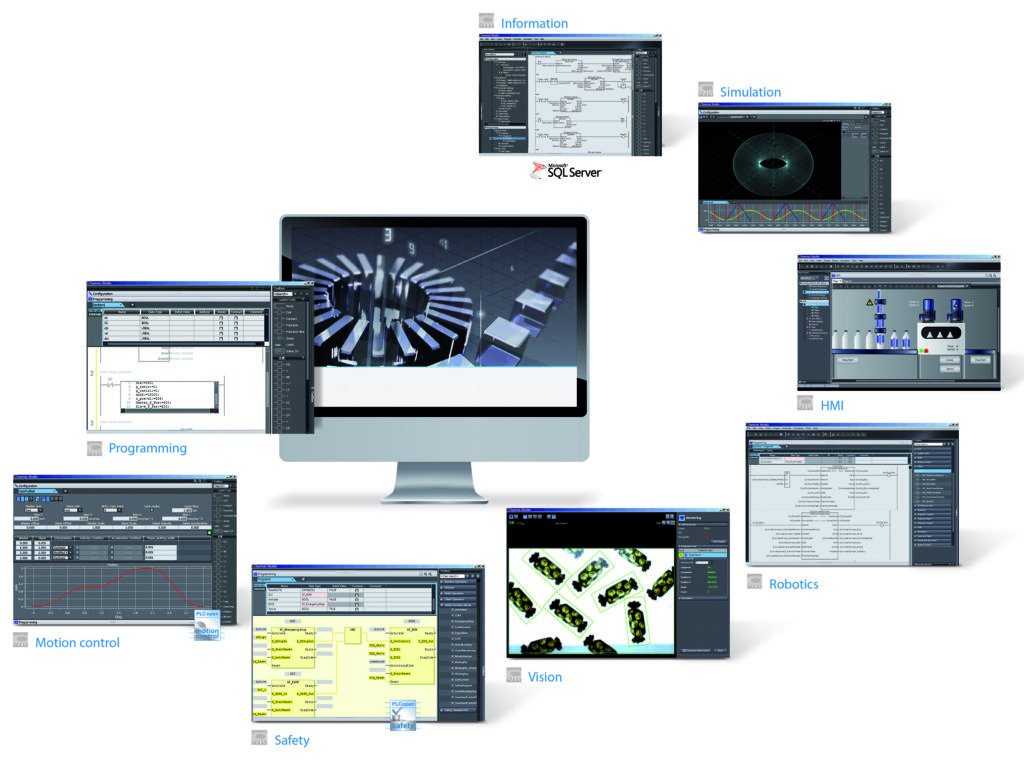
Complete process control: Essential for continued relevancy in manufacturing
January 10, 2023
By Thomas Kuckhoff
Brought to you by Omron Automation Americas
Tips for reducing the complexity brought on by an excess of niche software platforms
 All-in-one control system (Photo: Omron Automation Americas)
All-in-one control system (Photo: Omron Automation Americas) The COVID-19 pandemic has taught manufacturers many new lessons. However, the one that it has reinforced is the importance of being able to control the entire manufacturing process. Without complete process control, manufacturers are vulnerable to ever-changing buyer demand, unpredictability in supplier delivery, threats of substitutions and the rise of new competitors. Without proper industrial control systems in the connected manufacturing facility, manufacturing firms can fall out of relevancy quicker than ever.
The scale of globalization over the past few decades has created a wide breadth of competition. Establishing proper industrial control systems not only allows manufacturing firms to be flexible enough to accommodate new consumer demand but also to protect their core customer base. Manufacturing facilities that intentionally design comprehensive control, transparent communication and equipment lifecycle management into their facility’s architecture give themselves the ability to stay at the forefront of exponentially growing markets. This becomes even more apparent when national economies weigh the risk and rewards of onshoring versus offshoring supply chains.
How technologies from different sources create excess complexity
While we, automation manufacturers, like to tout the number of tools in the toolbox, the real value to manufacturing facilities is how these tools connect together to create a measurable contribution to the bottom line. As when we connect pieces together we gain economies of scale within our own facility as different automation technologies that are used together in a harmonious ecosystem can act as a single, transparent machine control platform.
As an example, many manufacturing facilities implement different solutions for vision, motion, safety and data collection. This is common as often these systems are not installed simultaneously. At the very minimum, this can result in four different software packages, engineering training curriculums, input/output hubs, protocols and systems to maintain version control as well as updates to remain cyber secure. While the production facility may see a production output increase allowing for the facility to generate more top-line revenue, the hidden costs for these different systems can negate these gains on the profit and loss statement, resulting in lower bottom-line net earnings.
The first step in making things better: One controller, one connection, and one software
The solution that can solve the complications above is selecting tools that increase top-line production without jeopardizing the bottom line. In the machine control industry, we see this through a synergy of tools while using the tools as they were designed. Striving for one controller, one connection, and one software is a great start. One controller allows for a transparent view of how your ones and zeroes are moving through the process, and it also decreases the number of spares on hand. One connection allows for all components, current and future, to plug and play in a friendly way, speeding up maintenance regardless of the operator on shift. One software lets you program version control across the facility, enabling process improvements to be brought across the facility more quicker.
The next step: Proper version control
Proper version control is just as important for continuing to advance the control system. Programmers can effectively overcome the problems of the future by understanding how processes evolve and learning from past issues. By documenting the evolution of a program version, transparency is increased, and gains made in one operation can quickly be scaled across the facility. This allows manufacturing facilities to create standard processes which are in the best interest of all the facility’s stakeholders.
Dealing with “quick fixes”
Quick fixes in a manufacturing process are numerous over the course of a production year. Quick fixes help shifts meet their targets during the late hours of the night. By documenting these quick fixes, engineers, line operators, and operation management can review the software changes together, offline — without affecting production — in order to understand why a fix was needed at all. Thus, diagnosing and treating the objective problem is not a perceived symptom. Without proper documentation, facilities are likely to repeat mistakes of the past.
How all-in-one platforms help deal with the need for future changes
When manufacturing facilities look to select an all-in-one platform, there is one major concern: uncertainty about the future. Fears about being left behind — or worse — from making the wrong decision and being left to start all over again in a few years have a huge impact on decision-making. The power of all-in-one platforms is that they let you change the implementation of exponentially growing technology without incurring massive costs. We hear these being distilled down to industry terms such as “scalability” and “flexibility,” but the truth is that these platforms give firms the ability to determine their own destiny without breaking their budgets every time a technological breakthrough occurs.
Change is the price of survival, and how we change is based on the opportunities we have in front of us. An all-in-one platform is immensely powerful, as it lowers the inertia to change. If your single controller is programmed by a single platform which communicates on a single globally open deterministic network, it isn’t hard to imagine how easy it is to increase the scope of the platform when all the data is already moving on a single, traceable path.
Tips for selecting an industrial control software
When starting the industrial control software selection process, it’s often best to start with the end in mind and to define the meaning of success. Does success mean automating one small task? Treating the immediate danger and nothing more? Or starting down the path to complete facility-wide process control?
While the scope of the software should be understood, facilities should strive for the lowest number of distinct software platforms with the goal of just one. All-in-one software platforms are designed to be scaled, allowing facilities to spread out plant-wide automation over multiple capital projects and achieve substantial returns on each investment while reducing the total cost of ownership. By understanding the different ends, customers won’t inadvertently become overburdened with licensing fees (as these fees can quickly add up). When selecting software to be the basis for facility-wide control, be sure to ask questions — obvious ones, hard ones and anything else that comes to mind. Many software packages have different fee structures, and these should be fully understood.
Industrial automation can be complicated if there is no vision for what facilities want to achieve. The good news is that all-in-one platforms don’t have to be complicated, as many industrial automation firms measure their success by their customer’s success. Proof-of-concept centers, which are becoming more prevalent, allow facility leadership to see firsthand how an all-in-one platform will perform in their specific facilities. Lifecycle management is being built into machine automation portfolios. Firmware updates, software updates, and hardware upgrades are becoming more backwards compatible, allowing customers to maintain their cyber security and keep their machines relevant without re-building their entire facility.
About the author
 Thomas Kuckhoff has pioneered the design and performance of innovative products across business portfolios in the industrial automation industry. He is the authoring inventor of thirteen U.S. patents, holds a green belt in Lean Six Sigma and has been recognized as Greenville South Carolina Business Journal’s Best and Brightest 35 and Under. His current role at Omron Automation is to lead the automation and controller business as product manager for the Americas. While Thomas’ role is product manager, his passion is to grow his team to achieve world-class results as a respective and inclusive collective.
Thomas Kuckhoff has pioneered the design and performance of innovative products across business portfolios in the industrial automation industry. He is the authoring inventor of thirteen U.S. patents, holds a green belt in Lean Six Sigma and has been recognized as Greenville South Carolina Business Journal’s Best and Brightest 35 and Under. His current role at Omron Automation is to lead the automation and controller business as product manager for the Americas. While Thomas’ role is product manager, his passion is to grow his team to achieve world-class results as a respective and inclusive collective.
Advertisement
- CME calls for increased Canada-U.S.-Mexico cooperation to drive North American propsperity
- Top five trends in motion control